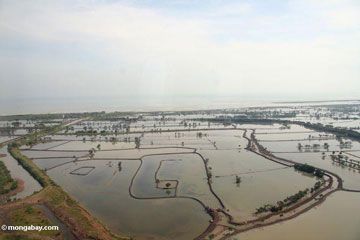Mangroves are key to healthy fisheries, finds study
Mangroves worth $37,500 per ha each year for fisheries
mongabay.com
July 21, 2008
Mangroves serve as a critical nursery for young marine life and therefore play an important role in the health of fisheries and the economic well-being of fishermen, report researchers writing in the early online edition of the Proceedings of the National Academy of Sciences.
Analyzing fish landings in 13 regions in the Gulf of California, Mexico, Octavio Aburto-Oropeza of the Scripps Institution of Oceanography at the University of California at San Diego and colleagues found that fishing yield was directly proportional to the length of coastline forested with mangroves. The scientists used the findings to estimate the monetary value of mangroves at $37,500 per hectare per year — an amount more than 600 times higher than estimates by the Mexican government.

|
“The forest is essential to the long term well-being of many other people whose livelihoods depend on the fisheries,” said coauthor Enric Sala, an adjunct professor at Scripps.
The researchers say the value of mangroves will likely increase as world fisheries continue to decline. They hope the results will create new impetus to protect the Gulf of California’s mangroves, which are disappearing due to tourism development and the establishment of shrimp farms.
“Our results suggest much higher values for mangroves than in previous work and should inform future development decisions in the Gulf of California; if mangroves are to be converted for development and services of the ecosystem lost, then users depending on these ecosystem services should be compensated,” said coauthor Jason Murray, currently a professor of the University of South Carolina
 Mangrove forest clearing for aquaculture in Indonesia.
|
The study adds to a growing body of research on the economic value of mangroves. A 2006 report by the United Nations Environment Programme (UNEP) noted that ecosystem services afforded by mangrove forests in Thailand are worth $35,000 per hectare, while a 400 square kilometer area of mangrove forest in Matang, Malaysia supports a fishery worth US$100 million a year.
Beyond serving as a refuge for juvenile marine organisms, mangroves filter sediment and buffer coastlines against erosion and storm surge.
Globally mangrove forests are disappearing at a rate of 1-2 percent per year, a pace that surpasses the destruction of adjacent ecosystems, coral reefs and tropical rainforests. The U.N. Food and Agriculture Organization estimates that mangroves are critically endangered or approaching extinction in 26 out of the 120 countries in which they are found.
Octavio Aburto-Oropeza, Exequiel Ezcurra, Gustavo Danemann, Víctor Valdez, Jason Murray, and Enric Sala (2008). Mangroves in the Gulf of California increase fishery yields. PNAS July 25, 2008.















